Lepus Leaps for Easter in Evening, Luna Passing Pre-Dawn Planets Grants Galaxy Viewing!
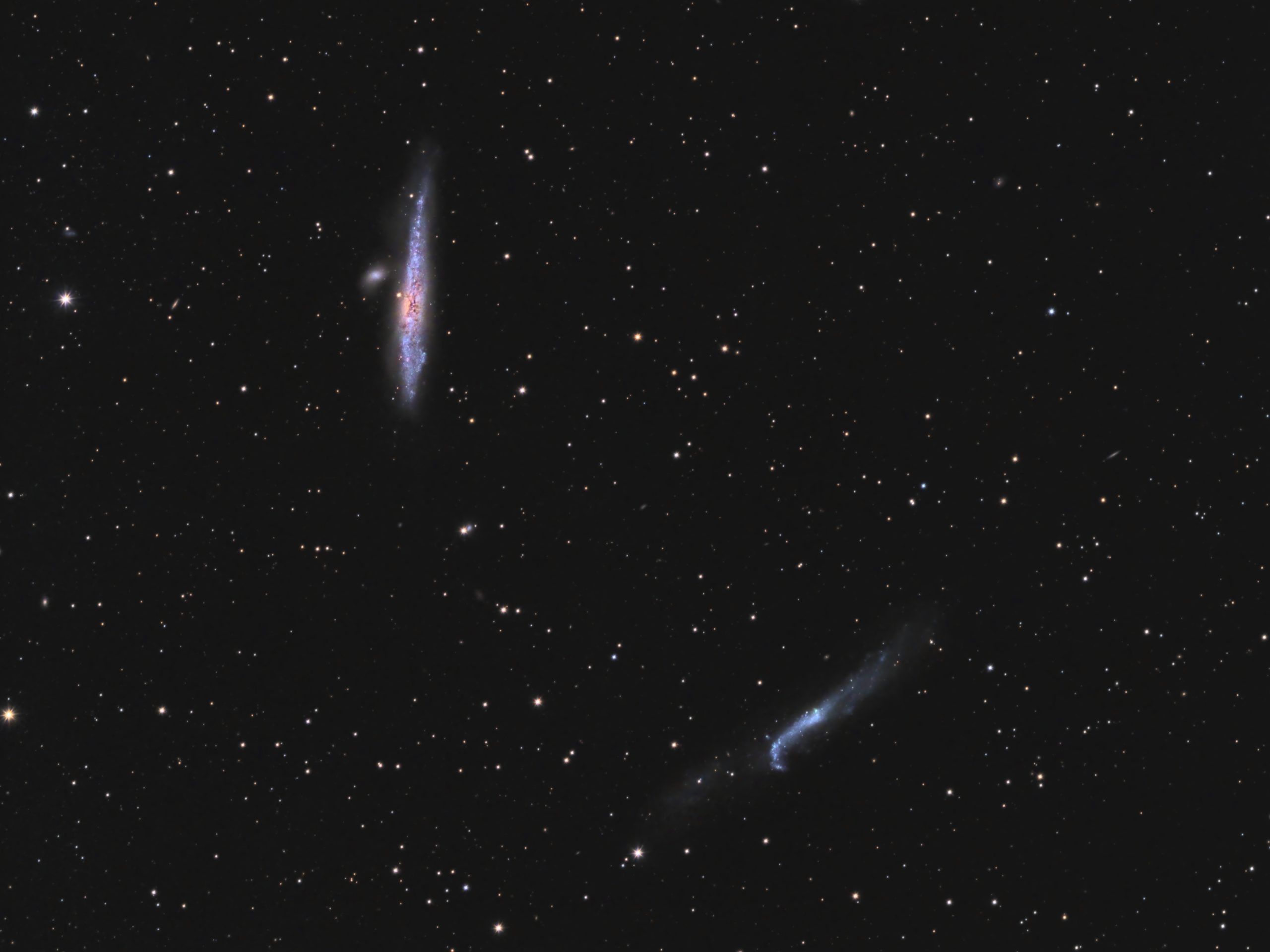
This image of the Whale Galaxy (top left) and the Hockey Stick Galaxy (lower right) was captured by AstroDoc Ron Brecher of Guelph on March 16, 2019. The image spans about 1 degree of sky. Ron’s galleries of images are at www.astrodoc.ca
Hello, Galaxy-season Stargazers!
Here are your Astronomy Skylights for the week of April 4th, 2021 by Chris Vaughan. Feel free to pass this along to your friends and send me your comments, questions, and suggested topics. You can also follow me on Twitter as @astrogeoguy! Unless otherwise noted, all times are expressed in Eastern Time. To subscribe to these emails please click this MailChimp link.
I can bring my Digital Starlab portable inflatable planetarium to your school or other daytime or evening event, or teach a session online. Contact me through AstroGeo.ca, and we’ll tour the Universe, or the Earth’s interior, together!
The moon is out of the night-time sky this week while it visits the gas giant planets in the eastern pre-dawn. That delivers stargazers around the world excellent evening skies for galaxy-viewing. I point out a number of relatively easy to find galaxies. In evening, Mars is forming a triangle with its reddish doppelgangers Aldebaran and Betelgeuse – and look below Orion for the Easter Bunny! Read on for your Skylights!
Happy Easter!
I wrote about the full moon sets the timing of Easter here.
If you’re looking the celestial Easter Bunny, he’s hopping below the constellation of Orion (the Hunter)! The constellation of Lepus (the Hare) is centred below Orion’s feet, about two fist diameters below the three bright stars of Orion’s Belt. After dusk in early April, Orion is tilting west in the lower part of the southwestern sky. Start a line from the middle star of the belt, Alnilam, and continue it down and to the left through Orion’s Sword and between the bright stars Saiph and Rigel. The next medium-bright star you arrive at will be the hare’s brightest star Alpha Leporis. Its common name is Arneb, or “hare” in Arabic.
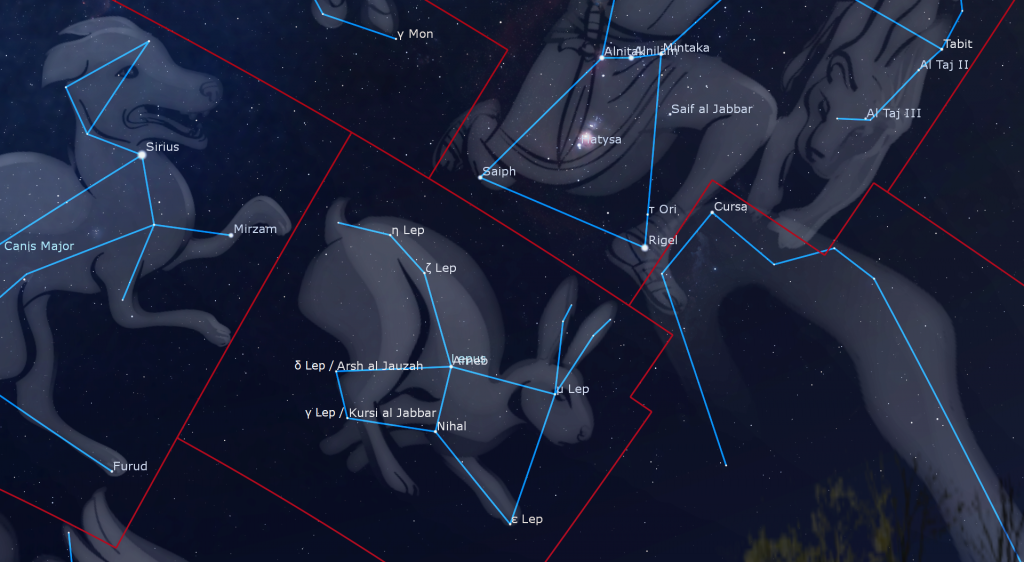
Two finger widths below Arneb is Lepus’ second brightest star Nihal. The fainter star that is positioned several finger widths to the left (celestial east) of Arneb is Delta Leporis. Below that sits a star designated Gamma Leporis. (Gamma is an easy-to-split double star.) Together, the four stars form a box-shape that used to represent a constellation called “the camels drinking”. Nowadays, they form the rabbit’s body – or perhaps his big fuzzy tail. His ears are a group of faint stars located a palm’s width to the upper right (celestial northwest) of Arneb. Brighter stars below the ears mark his eyes and his front paws. Hunt for the bunny, instead of the eggs!
The Moon
The moon officially reached its third quarter phase at 6:02 am Eastern Time (or 01:30 Greenwich Mean Time) today (Sunday). The third quarter moon looks half-illuminated, on its western side – towards the pre-dawn sun. At third quarter our natural satellite always rises in the wee hours of the night and then remains visible in the southern daytime sky all morning. That leaves evening skies all over the world darker, and ideal for observing deep sky targets until early next week.
When the moon rises after 4 am local time on Monday morning, it will shine in the south-southeastern sky between the bright planets Jupiter and Saturn on its left (east) and the Teapot-shaped stars of Sagittarius (the Archer) on its right (west).
In the southeastern sky before dawn on Tuesday the waning crescent moon will be positioned several finger widths to the lower right (or 4.5 degrees to the celestial south) of magnitude 0.75 Saturn. Since brighter Jupiter will be shining a short distance to their lower left, the grouping will make a nice photo opportunity when composed with some interesting landscape. The moon’s visit with the bright morning planets will continue on Wednesday morning; however, the moon won’t clear the southeastern horizon until after 5:30 am local time. Once it does, its gorgeous slim crescent will sit less than a palm’s width below (or 5 degrees to the celestial south of) very bright, magnitude -2.1 Jupiter – close enough to view them together in binoculars, and setting up another nice photo.
If you have a cloudless southeastern horizon free of obstructions on Thursday and Friday morning, you can try and spot the even slimmer lunar crescent sitting just above the horizon in the brightening sky. Even though the waning moon will be 8 and 18 degrees away from the morning sun on Saturday and Sunday, respectively, the moon’s shallowly inclined orbit in morning at this time of the year will cause it to rise at about the same time as the sun – keeping the moon hidden from view.
The moon will officially reach its new phase on Sunday, April 11 at 10:30 pm EDT or 7:30 pm PDT. That translates to 02:30 Greenwich Mean Time (GMT) on Monday, April 12. While new, the moon is travelling between Earth and the sun. Since sunlight can only reach the far side of the moon, and the moon is in the same region of the sky as the sun, the moon becomes completely hidden from view from anywhere on Earth for about a day. Earth’s celestial night-light will return to shine low in the western evening sky after sunset next Monday.
The Planets
Mars is the only planet that is visible during evenings nowadays. This week, the Red Planet will continue its trek eastward between the lengthy horns of Taurus (the Bull). Once the sky darkens, a little before 9 pm local time, the unimpressive reddish dot of Mars will be located halfway up the western sky. Two of Mars’ doppelgangers, the bright reddish stars Betelgeuse in Orion (the Hunter) and Aldebaran in Taurus (the Bull) will form a large, tilted triangle. Mars sits at its upper right (northern) corner.
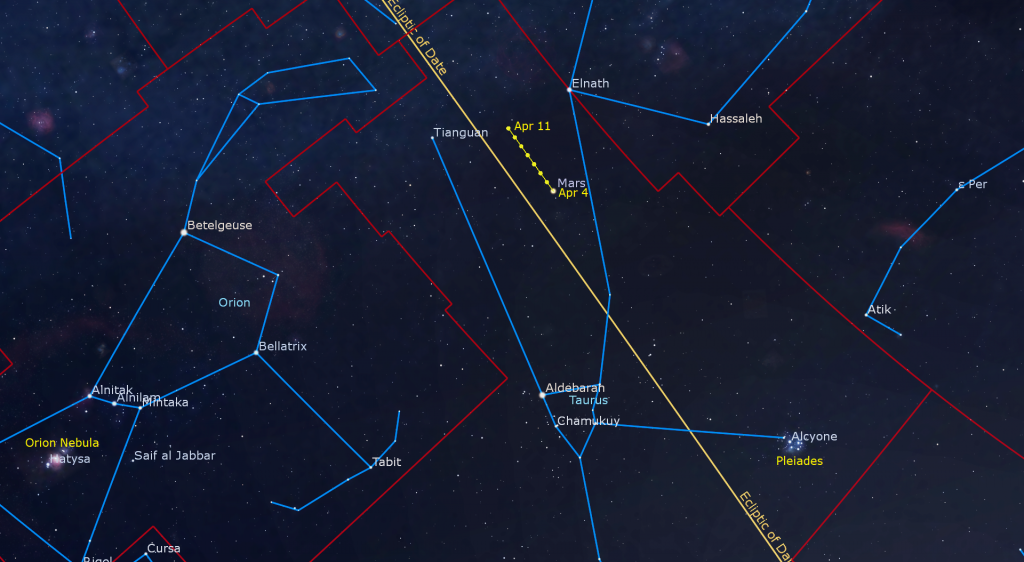
Look for Aldebaran sitting a generous fist’s diameter below (or 11 degrees to the celestial southwest of) Mars. Each night, Mars will shift a little farther from that star. Meanwhile, Betelgeuse is located about two fist diameters to Mars’ left (or 20 degrees to the celestial south). By the end of this week, the triangle will become very symmetrical.
Mars will set in the west after 1 am local time. Last Friday, Mars passed close to a large open star cluster designated NGC 1746. That cluster always sits between Taurus’ horns. Mars will still be close enough to the star cluster to see them together in binoculars for most of this week. The cluster is below (or west of) Mars.
Venus has now entered the western post-sunset sky – but it won’t swing wide enough of the sun to easily see its bright point of light until next week and beyond. We’ll have Venus as the “Evening Star” for the rest of 2021. Mercury will join Venus there toward the end of April.
Saturn and Jupiter are traveling slowly eastwards in their orbits among the dim stars of Capricornus (the Sea-Goat) in the southeastern pre-dawn sky. At the same time, the east-to-west drift of the entire sky due to Earth’s motion around the sun are causing everything to rise a few minutes earlier every morning.

This week, yellow-tinted, medium-bright, magnitude 0.7 Saturn will rise in a dark sky at about 4:15 am local time. Much whiter and brighter (magnitude -2.1) Jupiter will join the ringed planet about 30 minutes later, and will shine a generous fist’s diameter to Saturn’s lower left (or 13° east). Because Jupiter orbits closer to the sun than Saturn, it appears to move east faster than more distant Saturn – so those two planets are slightly increasing their separation from one another. (In actuality, it’s Jupiter that
Each integer change in magnitude value represents a two-and-a-half-times difference in brightness. Brightness increases as the magnitude value decreases. Doing the math, Jupiter is about 14 times brighter than Saturn. (The bright summertime star Vega anchors the brightness scale with a magnitude of 0.0.)
Due to the very shallow angle of the morning ecliptic in springtime, Jupiter doesn’t climb very high above the horizon before the sky brightens near sunrise, especially in mid-Northern latitudes. That makes it hard to obtain sharp views of the planet in a telescope. But the ecliptic is more vertical for observers in southerly latitudes – so the planet will be higher and clearer.
If you are willing to try getting up early and setting your backyard telescope for a look, the Great Red Spot will be visible on Jupiter on Tuesday and Thursday morning. On Friday morning, the small, round, black shadow of Jupiter’s moon Io will cross Jupiter (from 08:15 to 10:30 GMT). Events like these will be commonplace later in the year, when Jupiter will shine in the evening sky.
The Lion Leads Galaxies into View
If you missed last week’s introduction to Leo (the Lion), I posted it with sky charts here.
It’s Spring Galaxy Time!
Every spring in the Northern Hemisphere, the obscuring stars, gas and dust of our own Milky Way galaxy vacate the night sky overhead, leaving a literal window of opportunity for observers to see distant galaxies. This week’s moonless nights will provide us with especially dark skies for hunting these faint, but majestic objects. If you don’t have clear skies, the window will re-open in early-May.
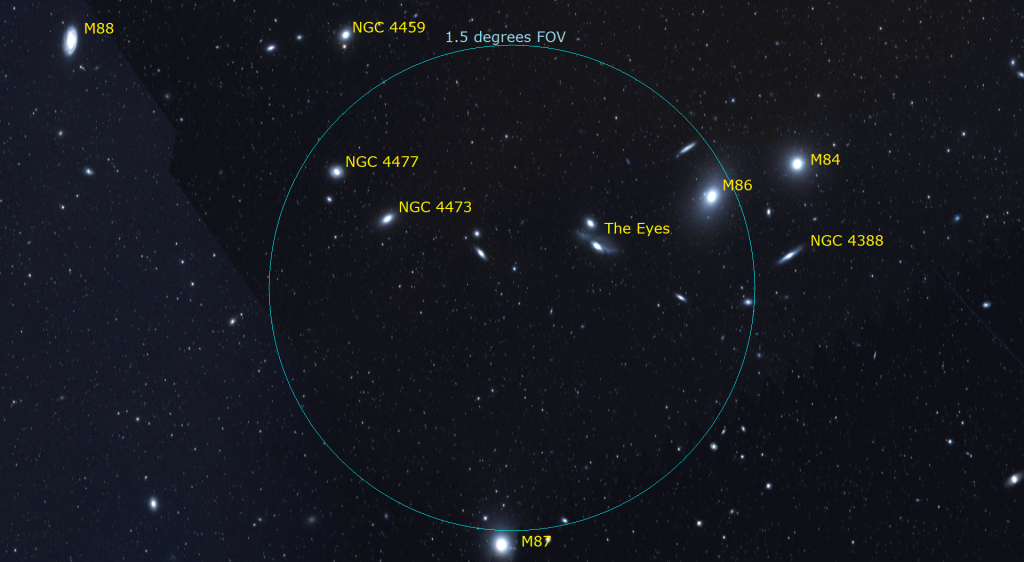
On the next clear evening this week, head outside and find a spot away from city lights and look east. About halfway up the sky, to the upper right of the bright star Arcturus, is the constellation of Coma Berenices, or “Bernice’s Hair.” This patch of sky contains the north galactic pole and therefore far fewer stars than the rest of the sky. It’s more or less overhead during late evening in April (and mid-evening in May) – perfect for viewing distant galaxies through the least amount of Earth’s distorting atmosphere. Coma Berenices and the constellations around it — Virgo (the Maiden), Leo (the Lion), Ursa Major (The Big Dipper’s home) and Canes Venatici (the Hunting Dogs) – all host a great many galaxies.
If you have a good-sized telescope (say a 4” or 102 mm aperture telescope, or larger) and a dark location that is free of light pollution, put your lowest power eyepiece (or lens) in it. That’s the one with the largest number printed on it. That long focal length eyepiece will show the largest possible patch of sky through the telescope – making finding galaxies easier.
Now aim your telescope at the medium-bright star named Denebola, which marks the tail of Leo (the Lion), and focus your telescope until Denebola is a pinpoint of light. Next, without changing the focus, move your telescope to point to a spot exactly midway between Denebola and the medium-bright star Vindemiatrix in Virgo (the Maiden), which sits nearly two outstretched fist diameters to the lower left (or 17 degrees to the celestial east) of Denebola.

If your sky is dark and your eyes are dark-adapted, you should see a number of dim fuzzy patches in the eyepiece. Those are galaxies! They are members of the Virgo Cluster of Galaxies – some larger, some smaller. If you can’t be sure you’re seeing them, try lightly tapping telescope tube while you are looking. The smudges will jump around a little, allowing your brain’s wiring to see them better. Nudge the telescope around to see how many you can find. (There are dozens in that patch of sky). If you mess up the focus, or get lost, just start over.
The biggest galaxies in that region are designated Messier 84 and Messier 86 (or M84 and M86). They are part of a curved line of galaxies known as Markarian’s Chain. Depending on your telescope type, that arc will curve down to the right or up to the right. Another prominent galaxy called M87 is located a short hop from the bend in the chain. If you’ve seen the pictures in the news of an orange ring surrounding a Black Hole, that’s the galaxy where it is – 60 million light-years away from us.
Galaxies that are oriented edge-on towards Earth appear in telescopes as short, indistinct, streaks of dim light. That’s because we’re seeing the collective light from all of that galaxy’s stars squeezed into a much smaller area of sky. Try to find the star named Gamma (γ) Comae Berenices or Al Dafirah. It’s close to the limit of visibility in light polluted skies, but easier to see in rural locations. It’s the uppermost of Coma Berenices’ three main stars. A collection of slightly dimmer stars gathered just to the right of Al Difirah represents the hair of Berenice. They are easy to see using binoculars.
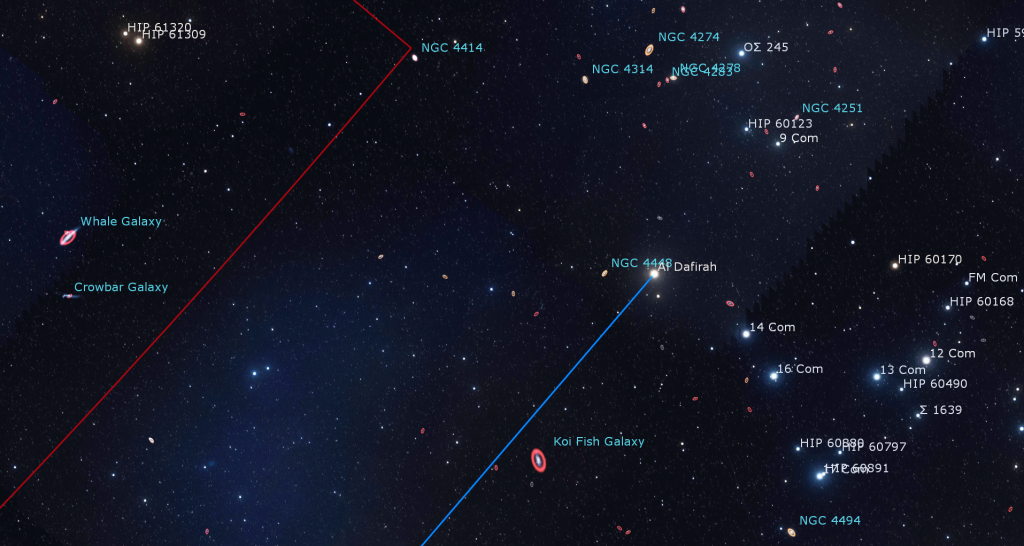
From Al Dafirah, aim your telescope a slim palm’s width to the left (or 5.5 degrees to the celestial northeast). There you might glimpse the Whale Galaxy (or NGC 4631). It’s called that because, when combined with a second, smaller galaxy sitting just beside it, it resembles a whale blowing water from its spout. Another prominent galaxy called the Crowbar Galaxy, or Hockey Stick Galaxy (or NGC 4656) is positioned close enough to the whale to show up in the same field of view of your telescope. It, too, appears as a slim, fuzzy slash of light. Those two major galaxies are about 25 and 30 million light years away from us, respectively.
Returning to Al Dafirah, scan your telescope two finger widths to the lower left (or 2 degrees to the celestial east) of that star and look for the Koi Fish Galaxy (or NGC 4559). Finally, point your telescope a few fingers widths below (or 3 degrees to the celestial southeast of) Al Dafirah. There you can look for the Needle Galaxy (or NGC 4565). This galaxy is dimmer than the other two, but it sits exactly edge-on to us – making it easier to see. It is located about 57 million light-years away from our solar system!
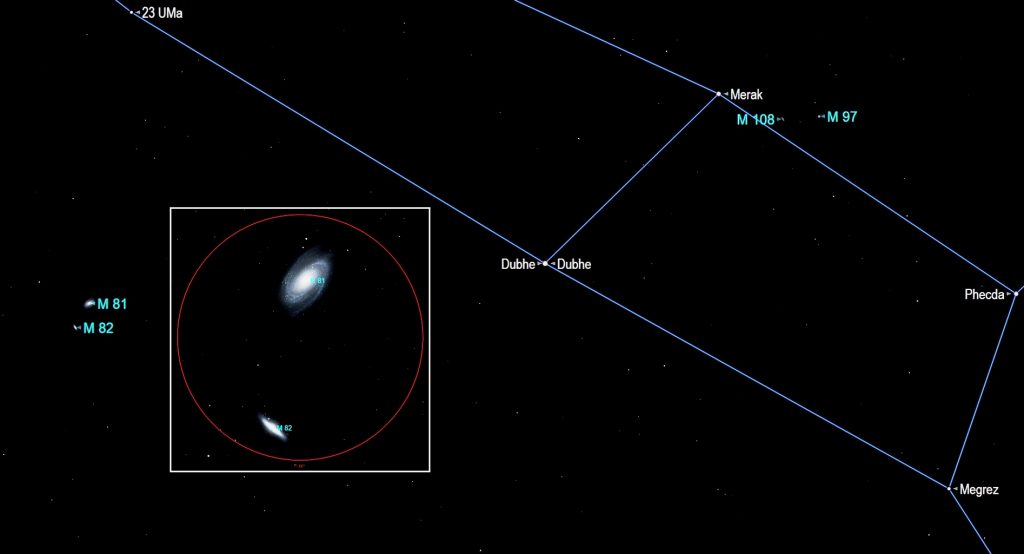
The Big Dipper asterism and its home constellation of Ursa Major (the Big Bear) are very high in the northern sky in late evening during early April – ideal for observing the spectacular galaxies they host in strong binoculars or backyard telescopes on moonless nights this week. Draw a line connecting the dipper stars Phecda to Dubhe, and extend it by an amount equal to their separation to arrive at the galaxy named Bode’s Nebula, otherwise known as Messier 81. It’s a magnitude 6.9 spiral galaxy oriented not quite face-on to Earth, making it appear relatively large and bright. A smaller, magnitude 8.4 galaxy named the Cigar or Messier 82 is located half a degree to the north. That allows both galaxies to be viewed together in the eyepiece of a telescope at low magnification (inset). Several other fainter galaxies can be found within a few degrees of Bode’s Nebula.
Under dark sky conditions, two impressive galaxies can be seen in binoculars and backyard telescopes by using the bright star Alkaid to locate them. That star marks the tip of the dipper’s handle. The Pinwheel Galaxy, or Messier 101, is a spectacular, large, face-on spiral galaxy positioned a palm’s width to the left (or 5.5 degrees to celestial north) of Alkaid, forming an equilateral triangle with Mizar, the double star at the bend of the handle. This relatively close galaxy (21 million light-years away) is nearly as large as the full moon in the sky. Since the galaxy’s light is spread over such a large area, its overall brightness is low.
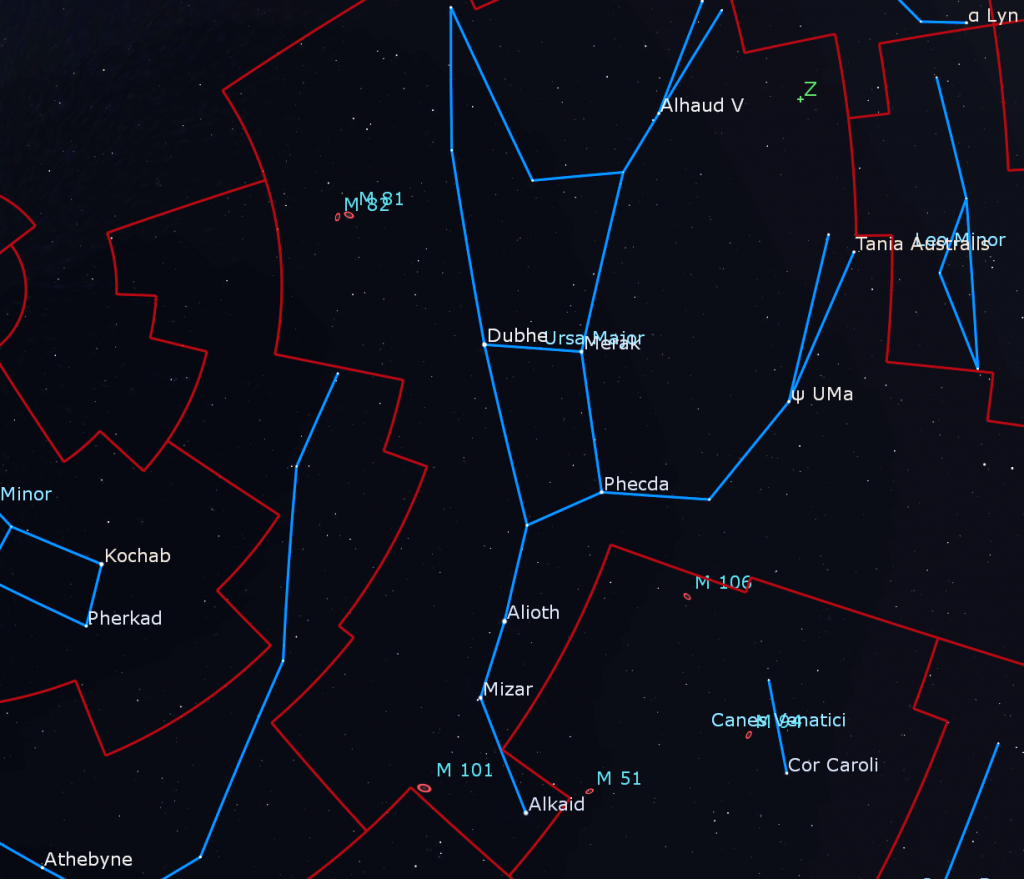
Aim your binoculars or telescope several finger widths to the upper right of Alkaid to discover the iconic Whirlpool Galaxy, aka Messier 51. This spiral galaxy’s angular size is smaller, but it will look somewhat brighter in your binoculars and telescope. A secondary galaxy core designated NGC5195 sitting alongside M51 is linked to the main spiral by a bridge of material (stars and dust).

On Space.com, you can read a column I wrote about classifying and viewing galaxies here. Let me know how you make out with your galaxy search!
Public Astro-Themed Events
Every Monday evening, York University’s Allan I. Carswell Observatory runs an online star party – broadcasting views from four telescopes/cameras, answering viewer questions, and taking requests! Details are here. Their in-person Wednesday night viewing has been converted to online via the observatory YouTube channel, where they offer free online viewing through their rooftop telescopes, including their 1-metre telescope! Details are here.
On Tuesday evening, April 6 at 7 pm EDT, The Dunlap Institute at the University of Toronto will present a free, live, online Astro Trivia Night! Fun Facts! Cool Prizes! Details and the registration link are here and here.
On Wednesday evening, April 7 at 7:30 pm EDT, the RASC Toronto Centre will live stream their monthly Recreational Astronomy Night Meeting at https://www.youtube.com/rasctoronto/live. Talks include the Sky This Month, video-assisted astronomy, life on Mars?, and Astronomy Camping. Details are here.
On Wednesday evening, April 7 at 7 pm, the Perimeter Institute in Waterloo will present Mapping the Universe with eBOSS, a free public talk and webcast about the vastness of the Universe. The speaker is Will Percival, Director of the Waterloo Centre for Astrophysics, holder of the Mike and Ophelia Lazaridis Distinguished Chair in Astrophysics at the University of Waterloo, and Associate Faculty member at Perimeter Institute. Details are here.
On Thursday, April 8 from noon to 12:30 pm, RASC National will continue their new weekly moon-observing series the Moon at Noon featuring Jenna Hinds and guests. Details are here and the registration link is here! Sessions will also be livestreamed to YouTube here and can be watched at any time.
My free, family-friendly Insider’s Guide to the Galaxy webcasts with Jenna Hinds of RASC National returns on Tuesday afternoon, April 13 at 3:30 pm EDT. We’re going to do a “March Break” session, and cover topics like Harry Potter connections to astronomy, how to make and use a starfinder, share star stories, and more! You can find more details, and the schedule of future sessions, here and here.
On Sunday afternoon, April 25 from 1 to 2 pm EDT I’m hosting an online session for RASC called Ask an Astronomer! We’ll explore the night sky together and answer your astronomy and space-related questions in simple language – using pictures, illustrations and planetarium software. The deadline to register is Friday, April 23 at 3:00 pm. Registration is here. A modest fee goes to support our ongoing efforts to deliver public programs at DDO.
Keep looking up, and enjoy the sky when you do. I love questions and requests. Send me some!